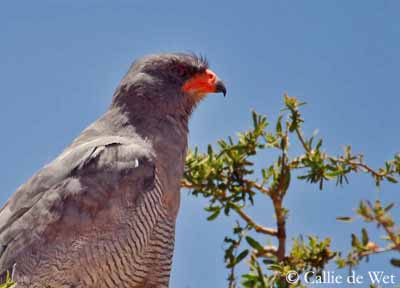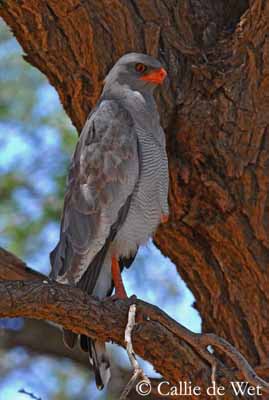
Southern Pale Chanting Goshawk
Melierax canorus
Accipitriforme Order – Accipitridae Family
BIOMETRICS:
Length : 55-65 cm
Wingspan : 110 cm
Weight : M : 410-750 g – F : 750-1000 g
DESCRIPTION:
S Pale Chanting Goshawk is a medium-sized raptor. Adult has pale grey upperparts. On wings, secondary coverts have fine white bars. Rump is white. Tail is dark grey, with outer feathers barred with white.
Underparts are white, finely barred with wavy grey bars. Chest is pale grey. Underwings are black on outer primaries, and white on inner primaries and secondaries. Tail is dark grey barred with white.
On the head, crown is grey, becoming paler on nape and upper back. Hooked bill is black, with yellow-orange cere and gape. Eyes are red or reddish-brown. Bare legs and feet are red.
Both sexes are similar in plumage, but female is larger than male.
DIET:
S Pale Chanting Goshawk feeds on rodents, lizards and insects. It may hunt birds (as quails) and hares.
PROTECTION / TRHEATS / STATUS:
S Pale Chanting Goshawk is widespread and generally common in its range.
Fr: Autour chanteur
All : Großer Singhabicht
Esp : Azor-lagartijero Claro
Ital : Astore cantante pallido
Nd : Zanghavik
Russe : Тусклый Певчий Ястреб
Photos de Callie de Wet
GALLERY
Texte de Nicole Bouglouan
Sources:
HANDBOOK OF THE BIRDS OF THE WORLD Vol 2 by Josep del Hoyo-Andrew Elliot-Jordi Sargatal - Lynx Edicions - ISBN: 8487334156
BIRDS OF AFRICA SOUTH OF THE SAHARA by Ian Sinclair and Peter Ryan - Princeton University Press Princeton and Oxford - ISBN: 0691118159
BIRDS OF PREY OF AFRICA AND ITS ISLANDS by Alan and Meg Kemp - Struik Publishers - ISBN: 1770073698
Wikipedia (Wikipedia, The Free Encyclopedia)

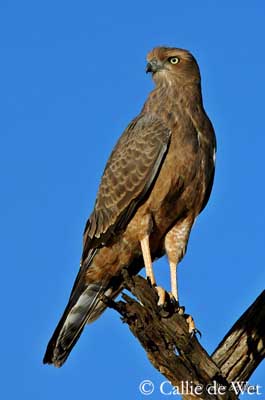
Juvenile has brown upperparts, with white rump. Tail is brown barred with darker brown.
Underparts are white with lower breast and belly heavily barred with brown. Underwing coverts are barred brown and white. Tail is barred greyish brown and brown below.
Head is dull brown on crown. Chin is white streaked with brown. Breast is buffy-white streaked with dark brown. Bill is black with grey cere and gape. Legs and feet are dull orange. Eyes are yellow.
Chicks are covered with pale grey down, with long darker down on crown. Eyes are grey-brown. Cere is greenish-grey. Legs and feet are dull pale yellow.
VOICE: SOUNDS BY XENO-CANTO
S Pale Chanting Goshawk is rather silent, but during breeding season, we can hear series of melodious whistling calls rapidly repeated “klueee-kli-kli-kli-kli-klip-kleeeep” usually uttered at dawn, while perched or flying.
We can also hear a long, drawn-out and high-pitched “kleeeeee-u, kleeeeee-u” at distinct intervals.
HABITAT:
S Pale Chanting Goshawk lives in savannahs, arid steppes and dry, open semi-desert. It is most common among scattered bushes and low thorn trees. In more arid areas, it is found along watercourses. It prefers limited groundcover areas.
RANGE:
S Pale Chanting Goshawk lives in eastern and southern Africa from where it is endemic.
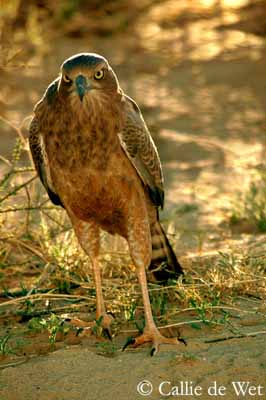
BEHAVIOUR:
S Pale Chanting Goshawk sits upright on its long legs when perched on a tree. It is often seen walking about on the ground. It can run very fast when pursuing a prey. But it also hunts from a perch. When prey is selected, it dives and runs after it. It also performs agile aerial chases after birds or hares running on the ground.
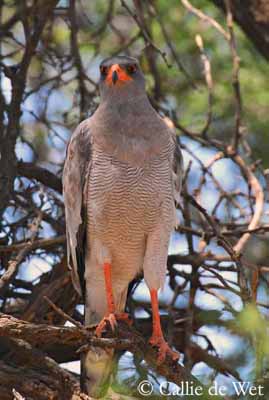
S Pale Chanting Goshawk is found singly or in pairs. Pair has a well-defined territory, and usually stays in and around the same group of trees. They perform short hunting trips from these trees.
When breeding season starts, male performs some displays. It perches on the top of a tall tree and utters its melodious call, often for hours. Both mates can soar together, making circles at about 200 to 300 feet in the sky. They also perform an undulating flight display while calling. Circling flight displays are made with slow wing beats.
FLIGHT:
S Pale Chanting Goshawk flies with steady, shallow wing beats, but it can change to fast, agile pursuit. It also alternates rapid wing beats with short glides.
REPRODUCTION:
S Pale Chanting Goshawk’s nest is built in thorn Acacias, in the upper fork of the tree, or on utility pole, at about 10 to 30 feet above the ground. Nest is made with small sticks, but it is a small loose structure where some rags and dung are added as lining. The shallow nest-cup in the centre may size up to 25 cm in diameter.
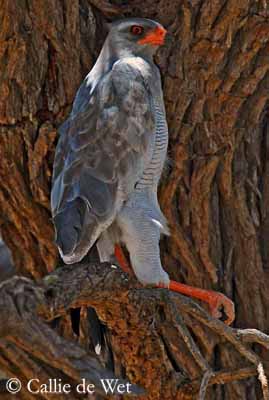
Female lays one or two pale bluish or greenish white eggs, at interval of several days, between June and February, according to the place. Incubation is by female alone. Only one young is reared by both parents.
After fledging, young remains near the nest for some months, and next year, it may return in the same area for displaying.
